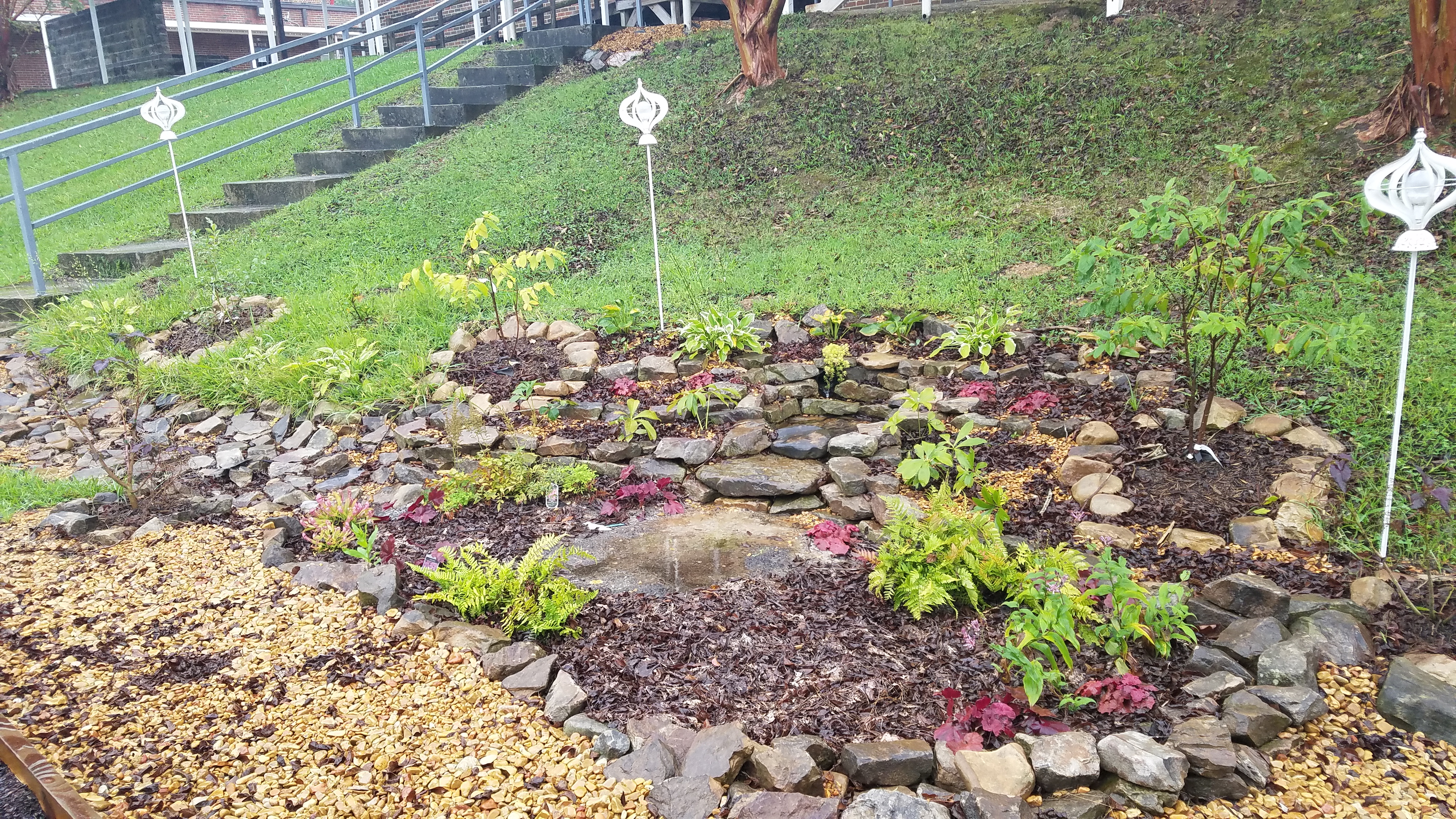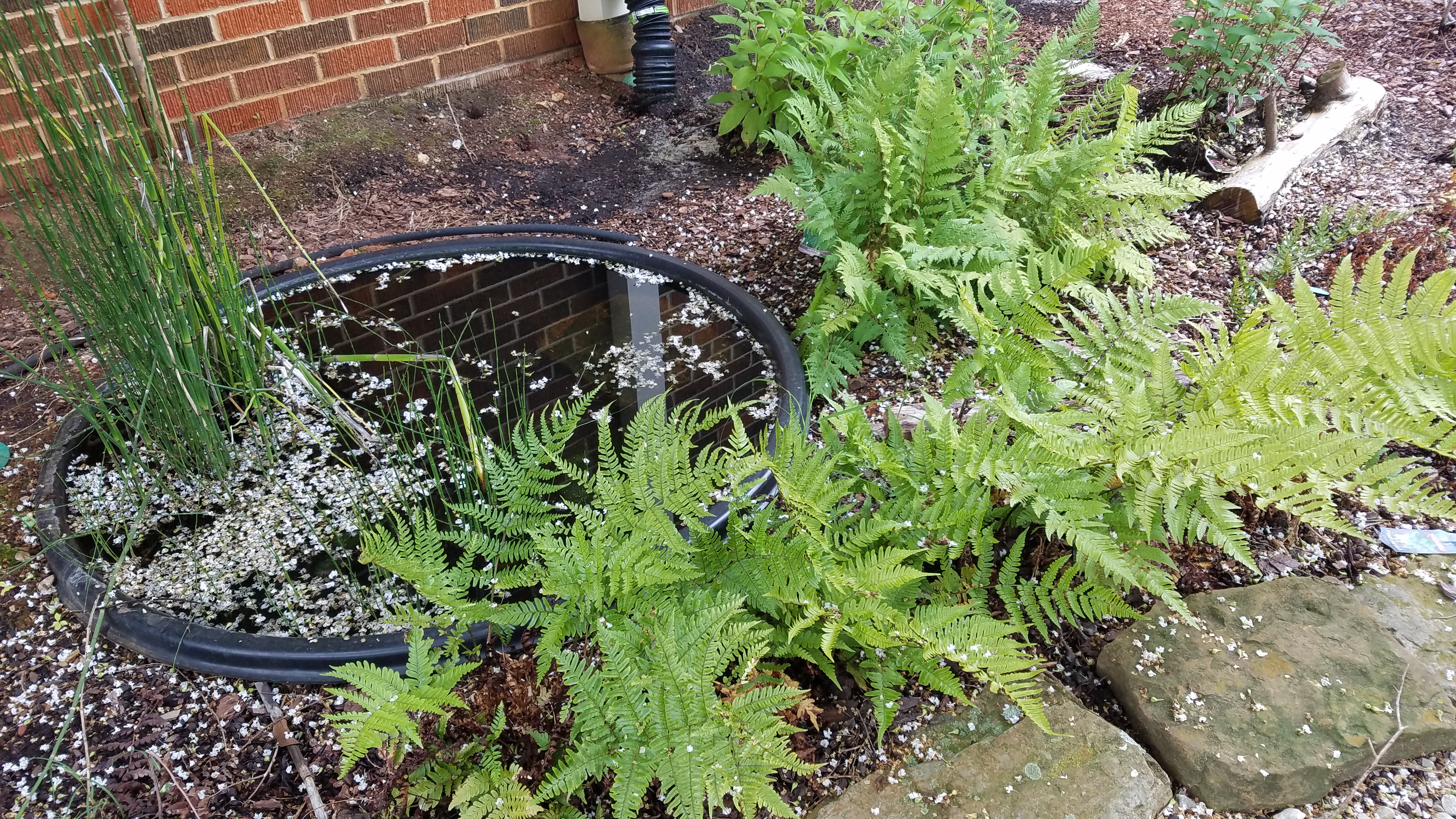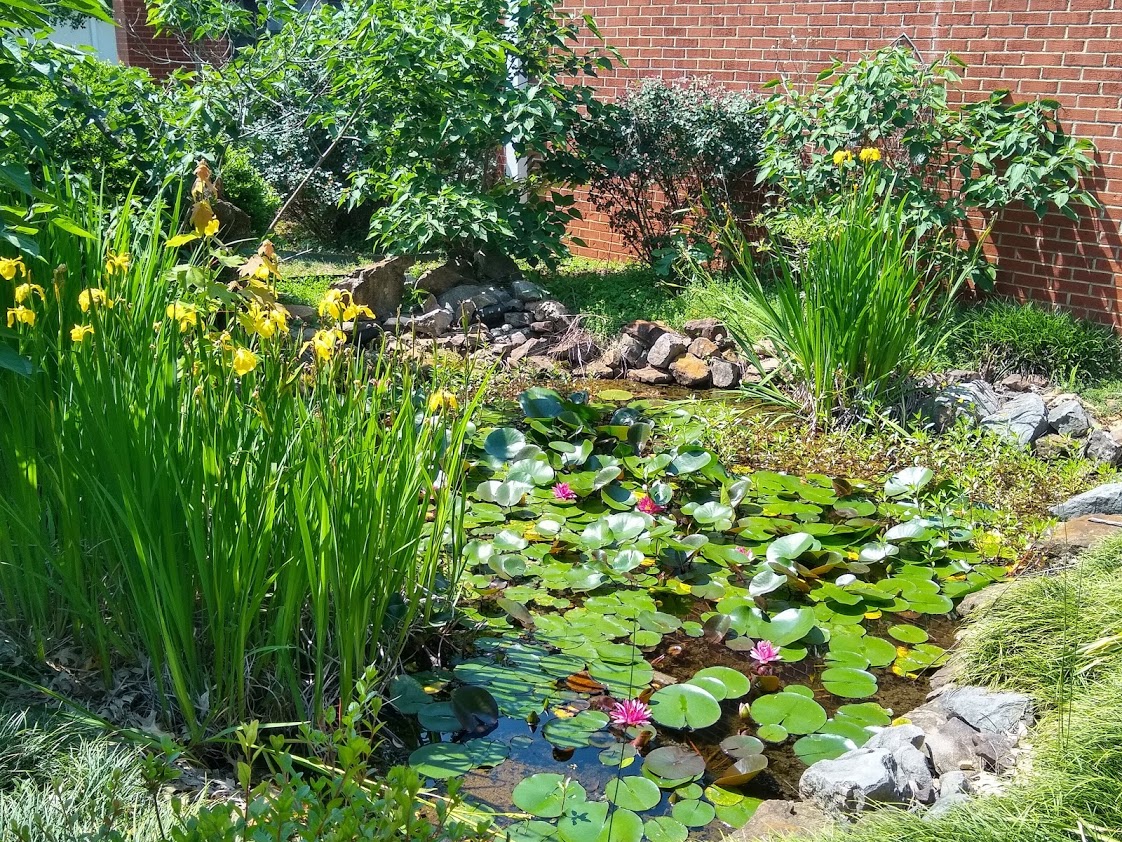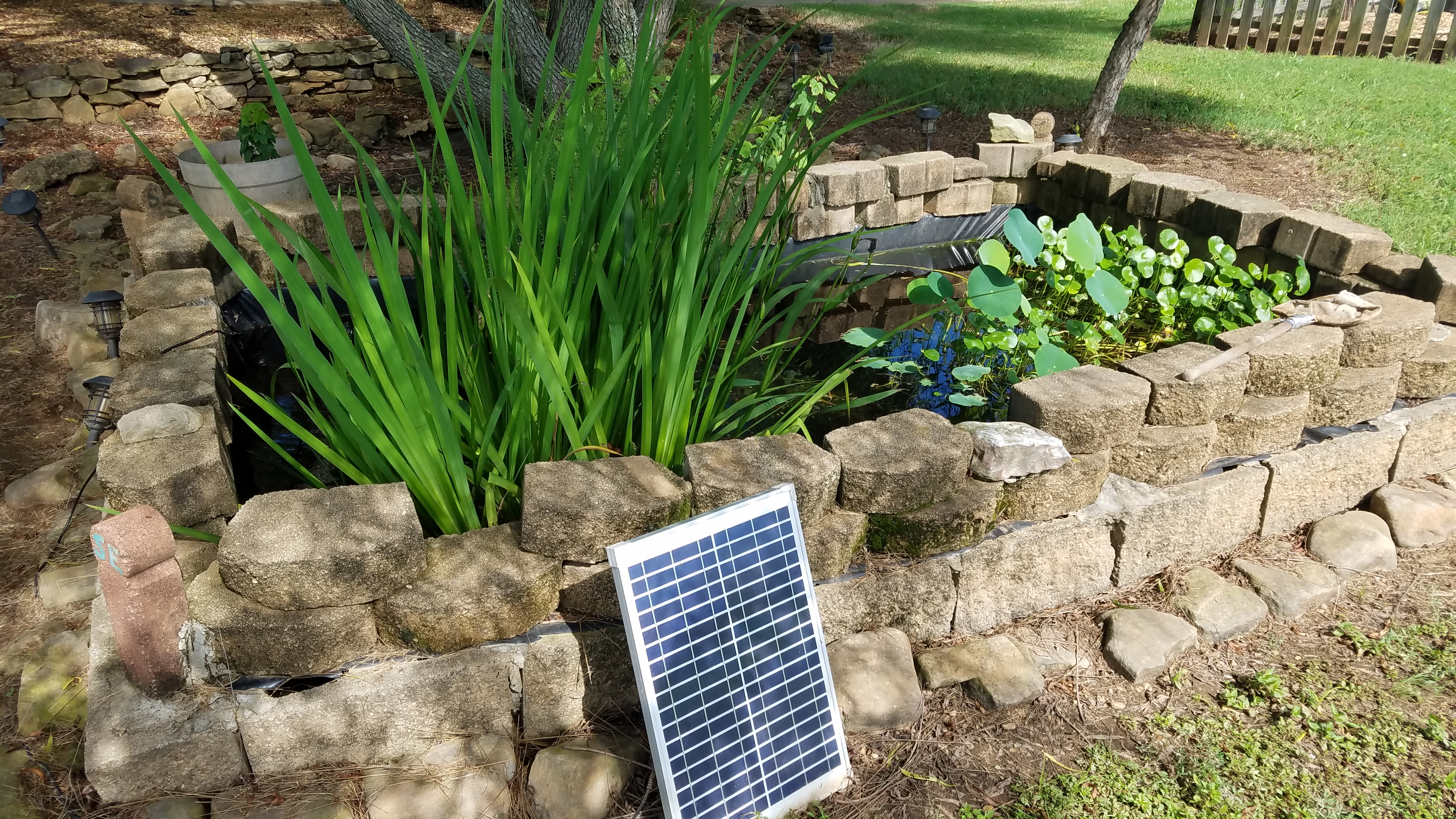Outdoor Learning Station: Frog and Toad Habitat
In an outdoor classroom, a Frog and Toad Habitat includes a small man-made pond with shallow water and a bog garden with damp soil, which provides the water and plants that frogs and toads need for food, water, shelter, and a place to raise their young.
Below is information to help you build, use and maintain your Frog and Toad Habitat:
Habitat Suggestions | Materials Budget | Plants & Plant ID Signs | Construction Instructions |
Educational Sign & QR Code | Activity Resources | Maintenance Tips | Example Photos
Frog and Toad Habitat Suggestions
A Frog and Toad Habitat should provide food sources, water, shelter, and places for frogs and toads to lay their eggs which will become tadpoles. To meet their habitat needs, this learning station will consist of two features built together as one habitat: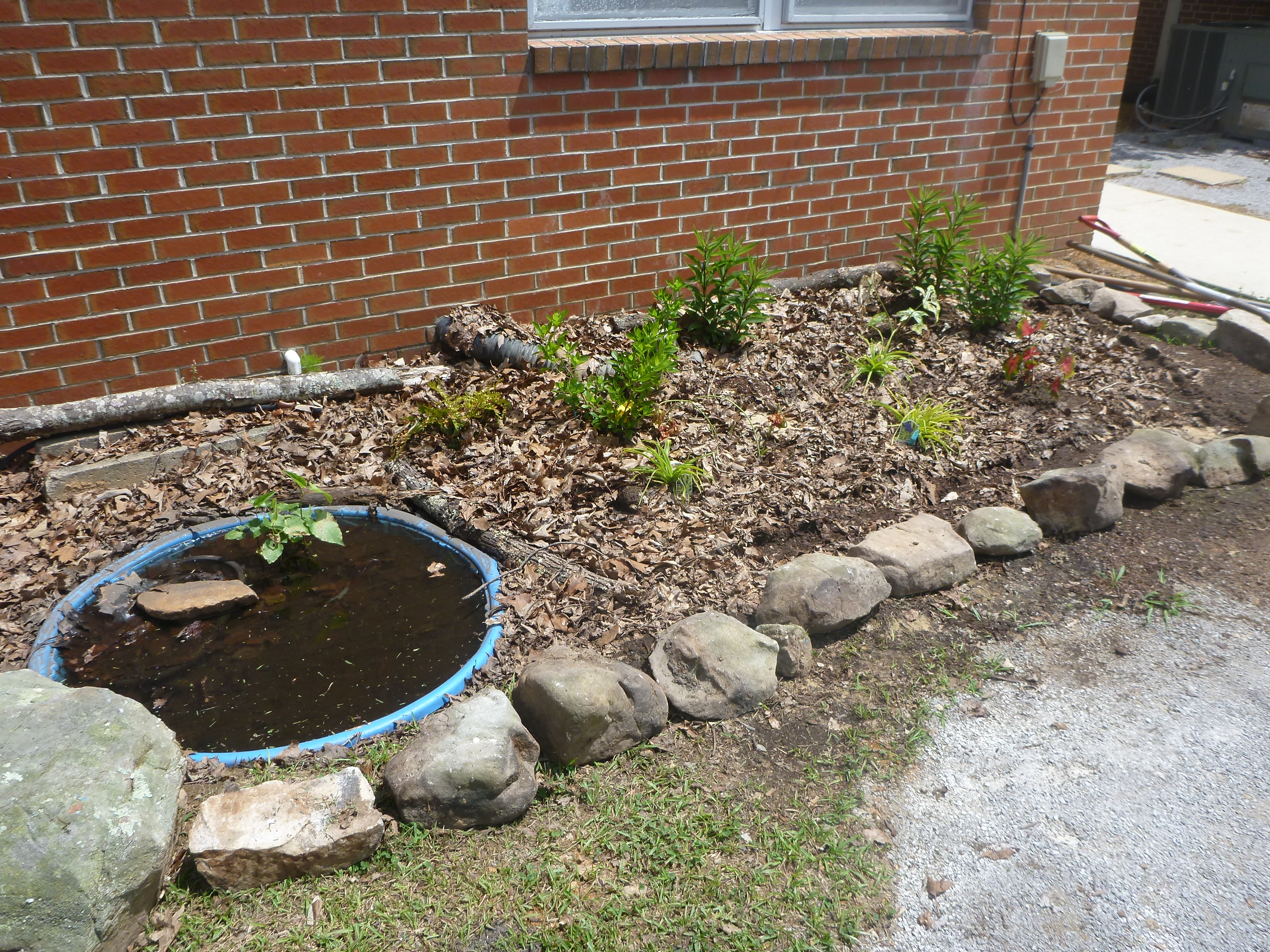
#1: Frog Pond – A man-made frog pond can be a pre-formed plastic pond that is at least 10-15 square feet in size and that is 6-12 inches deep. It should have shallow water only 6-8 inches deep and include native marginal aquatic plants such as lizard's tail (Saururus cernuus), arrow arum (Peltandra virginica), arrowhead (Sagittaria montevidensis), and pickerelweed (Pontederia cordata).
#2: Bog Garden – The bog garden can be created with 10 x 13 ft pond liner that is 12-18 inches deep and is filled with layers of peat moss, sand and compost (or dead, dried leaves). A bog is a type of wetland in a low-lying area where water collects, often times depositing dead, decaying plant matter. Thus, the soil becomes high in organic matter. Flora and fauna that thrive in a bog area must like a moist environment, but do not require standing water (like a pond, marsh or swamp) unless the bog area recently experienced heavy rains and has not yet drained. Native bog plants that you can include are joe-pye weed (Eutrochium purpureum), Southern woods fern (Dryopteris ludoviciana), Lady Fern (Athyrium filix-femina), beebalm (Monarda L.), blue-lobelia (Lobelia siphilitica), cardinal flower (Lobelia cardinalis), cinnamon fern (Osmunda cinnamonea), and swamp milkweed (Asclepias incarnata).
Install the Frog & Toad Habitat near a spigot so that you can fill the pond and bog with water during low rain levels. It is also important to install the bog in a flat area so that the soil in the bog garden will not wash out of the bog in a heavy rain. Install this habitat in full or part-shade, as frogs and toads prefer to not be in direct sunlight for extended periods of time.
Food: Frogs and toads begin life as herbivorous, aquatic tadpoles that feed on vegetation in the pond. As they go through metamorphosis their mouthparts change and they become carnivorous, terrestrial adults. The water in and vegetation around your pond will provide food directly for the frogs and toads as herbivorous tadpoles, as well as carnivorous adults by attracting insects and insect larva. You can also install 4-6 Solar LED Path Lighting Lights around the habitat to attract insects to the area at night.
Water: Frogs and toads require water for reproduction, their aquatic larval stage, and for keeping their skin moist and hydrated as adults. The pond will provide the water needed for frogs and toads throughout their whole lives. The aquatic plants inside of and around the pond will filter and aerate the water.
Shelter: The marginal aquatic plants in the pond, the rocks lining the pond, the bog plants and the moist soil in the bog will provide shelter for the frogs and toads. Shelter is important because frogs and toads are prey items for numerous animals that can visit your outdoor classroom.
Places to Raise Young: Frogs and toads must lay their eggs in water because the eggs are in a jelly-like mass (not a hard shell like bird or reptile eggs) that must be covered with water or the eggs will dry up and die. The tadpoles that hatch from the eggs also require water, as they breathe through gills and eat aquatic vegetation before metamorphosis. Adults do not stick around to protect the eggs or tadpoles, so vegetation and rocks offer protection from predators as the tadpoles grow and change into frogs.
Space: The pond should be at least 10-15 square feet in size and 6-12 inches deep. The bog should be at least 4 x 8 ft (or larger) in size. This provides ample food, water, and shelter for frogs and toads visiting your outdoor classroom.
Educational Sign: Use this educational sign at you Frog and Toad Habitat. You can send this PDF to a local sign shop to have an 8”x10” metal sign made to install at your learning station.
Materials Budget
These free Materials List and Budget documents include location suggestions, materials lists, estimated budgets, and native plant suggestions:
Example Frog & Toad Habitat Materials List & Budget: (Word Doc | PDF)
Plant Suggestions & Plant ID Signs with QR Codes
Check out more of our suggested plants for your frog and toad habitat on our "OC Plants" webpage.
Construction Instructions
These construction instructions include a list of tools & supplies needed for your work day as well as step-by-step construction instructions.
Example Frog & Toad Habitat Construction Instructions: (Word Doc | PDF)
Educational Sign & QR Code
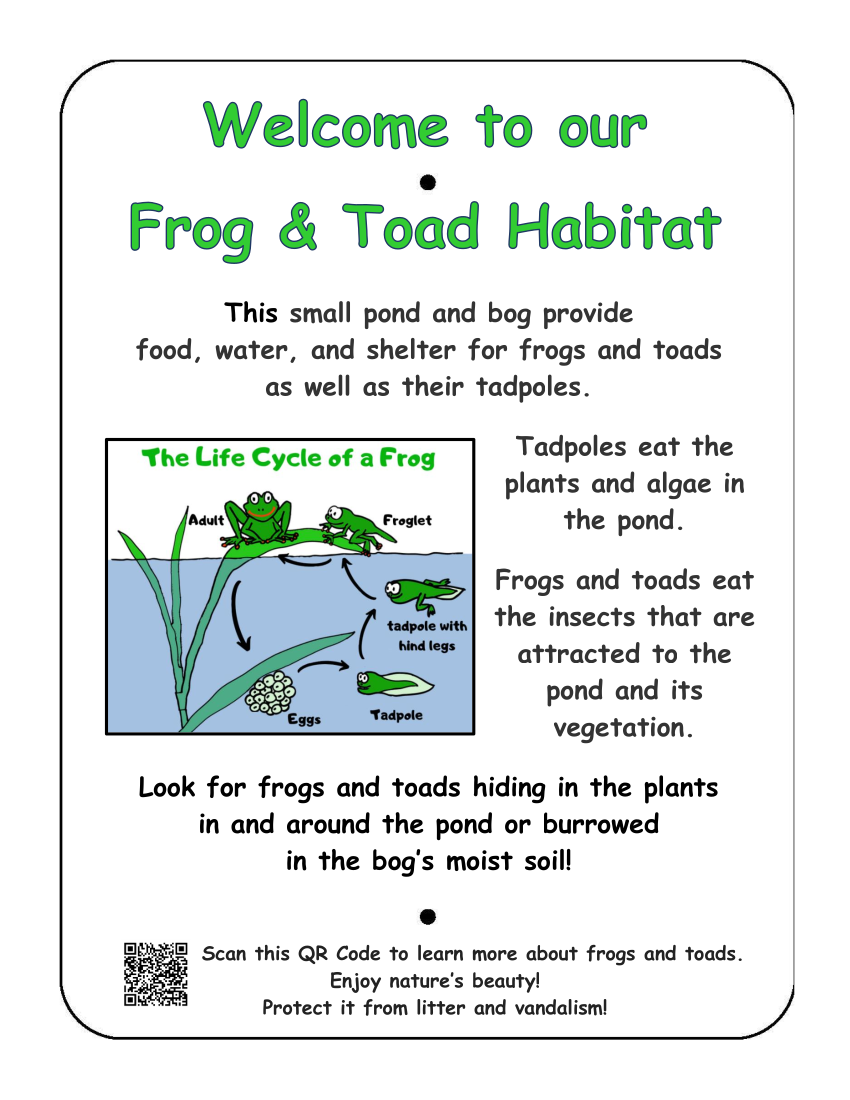
CLICK HERE to download the QR Code for this webpage.
You can inlcude the QR Code on the educational sign for your frog and toad habitat in your outdoor classroom: PDF | Word Doc
Activity Resources
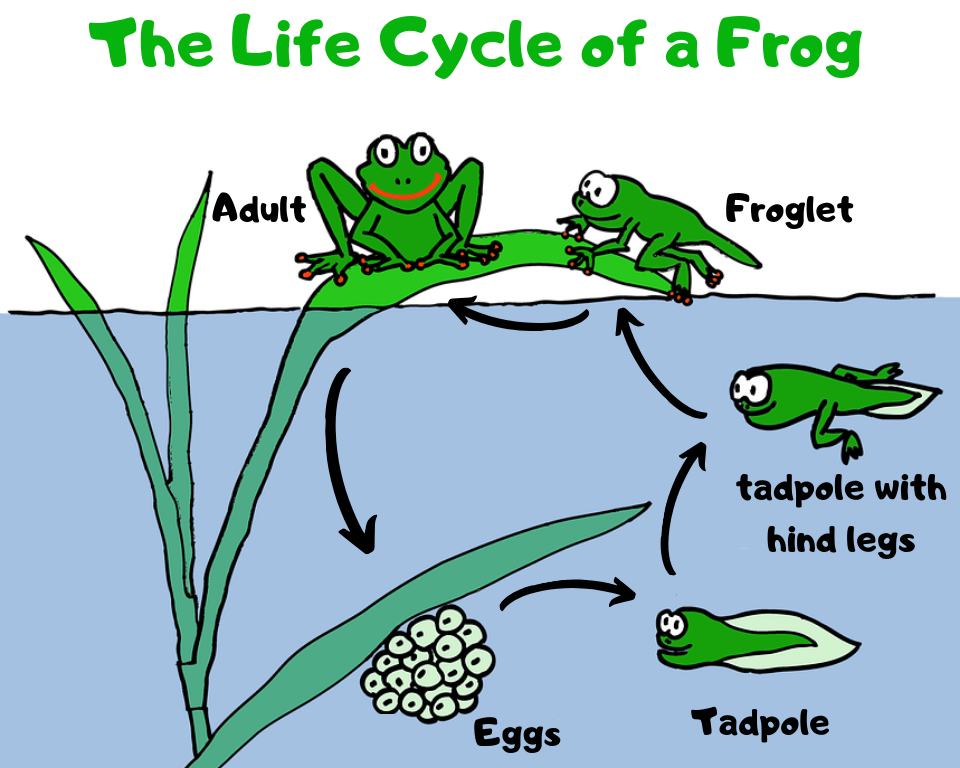
A frog and toad habitat provides your students the opportunity to closely observe the unique life cycle, physical adaptations, and behavior or native frogs and toads.
Use this Frog Life Cycle Poster to aid in your lessons.
Use our "Learn about Frogs and Toads and Their Habitat" webpage to help your students research frogs and toads including their life cycles and habitat needs.
Below are some free AWF Field Investigation Activities related to frogs and toads:
Get creative with your students and make “Toad Abodes”. Paint terra cotta pots and lay them on their sides, sunken into the dirt near your pond – they will serve as habitat for your toads and frogs. It is best to place them in an area where they will be surrounded by vegetation.
FrogWatch USA is a citizen science program that can provide your students opportunities to learn about wetlands in their communities by reporting on the calls of local frogs and toads. You can learn more about this program and become a volunteer on their website.
Maintenance Tips
To allow classes to adopt the Frog and Toad Habitat, use this Learning Station Adoption Form (Word Doc | PDF), along with the maintenance tips below:
To create a map of your school's Frog and Toad Habitat, use this Example Learning Station Map & Plant ID Form (Word Doc | PDF).
Example Photos
Questions: Contact the AWF at oc@alabamawildlife.org.
.
Below is information to help you build, use and maintain your Frog and Toad Habitat:
Habitat Suggestions | Materials Budget | Plants & Plant ID Signs | Construction Instructions |
Educational Sign & QR Code | Activity Resources | Maintenance Tips | Example Photos
Frog and Toad Habitat Suggestions
A Frog and Toad Habitat should provide food sources, water, shelter, and places for frogs and toads to lay their eggs which will become tadpoles. To meet their habitat needs, this learning station will consist of two features built together as one habitat:

#1: Frog Pond – A man-made frog pond can be a pre-formed plastic pond that is at least 10-15 square feet in size and that is 6-12 inches deep. It should have shallow water only 6-8 inches deep and include native marginal aquatic plants such as lizard's tail (Saururus cernuus), arrow arum (Peltandra virginica), arrowhead (Sagittaria montevidensis), and pickerelweed (Pontederia cordata).
#2: Bog Garden – The bog garden can be created with 10 x 13 ft pond liner that is 12-18 inches deep and is filled with layers of peat moss, sand and compost (or dead, dried leaves). A bog is a type of wetland in a low-lying area where water collects, often times depositing dead, decaying plant matter. Thus, the soil becomes high in organic matter. Flora and fauna that thrive in a bog area must like a moist environment, but do not require standing water (like a pond, marsh or swamp) unless the bog area recently experienced heavy rains and has not yet drained. Native bog plants that you can include are joe-pye weed (Eutrochium purpureum), Southern woods fern (Dryopteris ludoviciana), Lady Fern (Athyrium filix-femina), beebalm (Monarda L.), blue-lobelia (Lobelia siphilitica), cardinal flower (Lobelia cardinalis), cinnamon fern (Osmunda cinnamonea), and swamp milkweed (Asclepias incarnata).
Install the Frog & Toad Habitat near a spigot so that you can fill the pond and bog with water during low rain levels. It is also important to install the bog in a flat area so that the soil in the bog garden will not wash out of the bog in a heavy rain. Install this habitat in full or part-shade, as frogs and toads prefer to not be in direct sunlight for extended periods of time.
Food: Frogs and toads begin life as herbivorous, aquatic tadpoles that feed on vegetation in the pond. As they go through metamorphosis their mouthparts change and they become carnivorous, terrestrial adults. The water in and vegetation around your pond will provide food directly for the frogs and toads as herbivorous tadpoles, as well as carnivorous adults by attracting insects and insect larva. You can also install 4-6 Solar LED Path Lighting Lights around the habitat to attract insects to the area at night.
Water: Frogs and toads require water for reproduction, their aquatic larval stage, and for keeping their skin moist and hydrated as adults. The pond will provide the water needed for frogs and toads throughout their whole lives. The aquatic plants inside of and around the pond will filter and aerate the water.
Shelter: The marginal aquatic plants in the pond, the rocks lining the pond, the bog plants and the moist soil in the bog will provide shelter for the frogs and toads. Shelter is important because frogs and toads are prey items for numerous animals that can visit your outdoor classroom.
Places to Raise Young: Frogs and toads must lay their eggs in water because the eggs are in a jelly-like mass (not a hard shell like bird or reptile eggs) that must be covered with water or the eggs will dry up and die. The tadpoles that hatch from the eggs also require water, as they breathe through gills and eat aquatic vegetation before metamorphosis. Adults do not stick around to protect the eggs or tadpoles, so vegetation and rocks offer protection from predators as the tadpoles grow and change into frogs.
Space: The pond should be at least 10-15 square feet in size and 6-12 inches deep. The bog should be at least 4 x 8 ft (or larger) in size. This provides ample food, water, and shelter for frogs and toads visiting your outdoor classroom.
Educational Sign: Use this educational sign at you Frog and Toad Habitat. You can send this PDF to a local sign shop to have an 8”x10” metal sign made to install at your learning station.
Materials Budget
These free Materials List and Budget documents include location suggestions, materials lists, estimated budgets, and native plant suggestions:
Example Frog & Toad Habitat Materials List & Budget: (Word Doc | PDF)
Plant Suggestions & Plant ID Signs with QR Codes
Frog and Toad Habitat Native Plant Suggestions:
Customized plant identification signs with unique QR Codes that you can scan to open plant species’ webpages on AWF's website are available for the bolded species below. The webpages provide specific information about that plant species including a description of the plant, the ecological benefits that species provides, maintenance tips, and photos of the plant including its leaves, flowers & seeds. | Aquatic Plants | |||
| Arrow Arum | Horsetail | Lizard’s Tail | Pickerelweed |
| Bog Plants | |||
| Blue Cardinal Flower | Christmas Fern | Cinnamon Fern | Eastern Red Columbine |
| Great Blue Lobelia | Heartleaf Foam Flower | Joe-pye Weed | Lady Fern |
| Southern Woodfern | Spiderwort | Stokes Aster | Swamp Milkweed |
| Ground Cover Plants for Bog Berm | |||
| Ajuga | Native Violets | Wild Ginger | Woodland Stonecrop |
Check out more of our suggested plants for your frog and toad habitat on our "OC Plants" webpage.
Construction Instructions
These construction instructions include a list of tools & supplies needed for your work day as well as step-by-step construction instructions.
Example Frog & Toad Habitat Construction Instructions: (Word Doc | PDF)
Educational Sign & QR Code

CLICK HERE to download the QR Code for this webpage.
You can inlcude the QR Code on the educational sign for your frog and toad habitat in your outdoor classroom: PDF | Word Doc
Activity Resources

A frog and toad habitat provides your students the opportunity to closely observe the unique life cycle, physical adaptations, and behavior or native frogs and toads.
Use this Frog Life Cycle Poster to aid in your lessons.
Use our "Learn about Frogs and Toads and Their Habitat" webpage to help your students research frogs and toads including their life cycles and habitat needs.
Below are some free AWF Field Investigation Activities related to frogs and toads:
- Comparing Life Cycles (3rd): (Version #1: Word Doc / PDF) (Version #2: Word Doc / PDF) Students will compare their life cycle (the life cycle of a human) with the life cycle of an animal that they find in the outdoor classroom.
- What's the Scoop on Soil? (4th): (Word Doc / PDF) Students learn about the soils in your outdoor clasroom as they investigate the properties of four different soil samples and examine the soils' texture, color, capacity to retain water, and ability to support plant growth.
- Comparing Adult to Offspring (1st): (Version #1: Word Doc / PDF) (Version #2: Word Doc / PDF) Students will explore the outdoor classroom as they look for animal offspring and adults of the same species, which they will compare and contrast as they record their observations.
- Animal Features & Adaptations (1st): (Version #1: Word Doc / PDF) (Version #2: Word Doc / PDF) Students will explore the outdoor classroom as they look for an animal, and then they record their observations about it and analyze which of its characteristics (adaptations) help it survive.
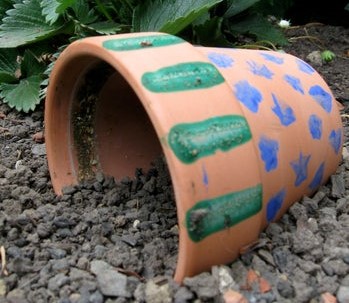 |
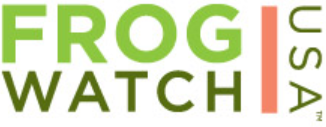 |
Maintenance Tips
To allow classes to adopt the Frog and Toad Habitat, use this Learning Station Adoption Form (Word Doc | PDF), along with the maintenance tips below:
To create a map of your school's Frog and Toad Habitat, use this Example Learning Station Map & Plant ID Form (Word Doc | PDF).
Example Photos
|
|
Questions: Contact the AWF at oc@alabamawildlife.org.
.
 Wildlife Tag
Wildlife Tag
